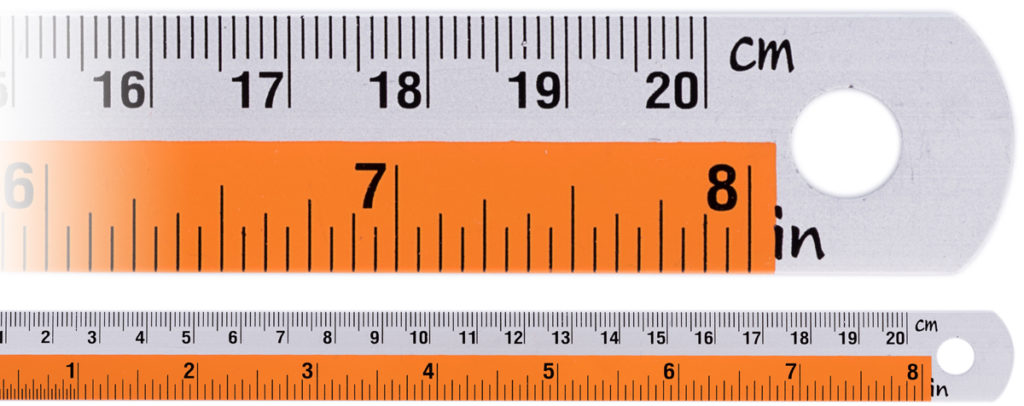
And now, an article on something completely practical and necessary — A Complete Guide to Using a Tape Measure. Don’t feel embarrassed about having to search for this because you’re not alone. In fact, over 75,000 people search for this every month. Yup — every month. You are in good company.
Let’s get down to basics and learn how to read these stupid little tape measures. Just kidding! Although, learning to read a tape measure can be frustrating, depending on what measurement system you’re born into.
How to Read A Tape Measure
Whether it be woodworking, metalwork, construction, or basic DIY, accurate measurements are essential. Knowing how to read a tape measure is the first skill any craftsman needs to master. This guide to using a tape measure will equip you with the proficiency needed to read precise measurements quickly and easily, like a true pro.
In the United States, measurements are usually presented in inches (and fractions of inches), feet, and yards. This is known as the imperial system. Most other regions use the metric system, millimeters, centimeters, and meters. It is a good idea to familiarize yourself with both types of tape measure. You may often come across European products and guides, using the metric system. Though the basic principle of reading a tape measure, and using one correctly, is universal.

Reading an Imperial Tape Measure
Every tape measure has markings with lines of varying lengths. The basic unit for an American imperial tape measure is Inches (In). Along the length of the tape measure, every inch is numbered, with the boldest longest line designated to each 1-inch marking.
Most tape measures will also have markings for feet (ft.). After every 12”, a foot marking will be prominently displayed, using a large bold number for each foot. This will often be displayed in red to make it more distinguishable.
In between every inch mark, you will find a line in the center, which is slightly shorter than numbered inch line, but longer than the other small densely spaced lines. This indicates a half-inch (½”). Halfway between each half-inch mark, are quarter-inch lines (¼”). These are slightly smaller than the half-inch lines. The smallest lines each indicate One-sixteenth-inch increments (¹⁄₁₆”). Every second ¹⁄₁₆” mark represents one-eighth-inch (¹⁄₈”). The ¹⁄₈” lines are slightly longer than the ¹⁄₁₆” lines. This means that a standard imperial tape measure is accurate down to ¹⁄₁₆”. Some may be accurate up to ¹⁄₃₂”, even ¹⁄₆₄”. Though most of the tape measure you find in hardware and department stores, have measurements down to ¹⁄₁₆”. You will find most instruction and DIY guides will not use measurements smaller than ¹⁄₈” or ¹⁄₁₆”.
When reading a tape measure, you start by identifying the largest unit, this would be feet or inches, indicated by a number. Identify the inch marking closest to the point you’re measuring. Next, you’ll look for the ½” mark, then the ¼”. Finally, you’ll count the ¹⁄₈” and ¹⁄₁₆” lines from the last inch, ½”, or ¼”. Essentially, you’re counting markings from the largest unit down to the smallest.
Example:
The closest numbered marking to the point you’re measuring is 8-inches. From here, the next mark is ¼”, followed by a ¹⁄₈” line, to the point we’re measuring. We now add these faction markings to the 8-inches where we started. We add ¼”, which is equivalent to ²⁄₈”, to ¹⁄₈”, taking our fraction to ³⁄₈”. The final measurement is, therefore, 8 + ³⁄₈” = 8³⁄₈”.
If our measurement is greater than 12”, we start at the closest marking for feet, then inches, followed by the ¼”, ¹⁄₈”, and ¹⁄₁₆” lines.

Reading a Metric Tape Measure
The metric system of measurement is simpler and easier to use. There are fewer markings and, because metric measurements are in units of 10, the decimals make our calculations easier. The Numbered lines, which are longer, indicate centimeters (CM), 1 Centimeter = 10 millimeters (MM). Between each centimeter numerically marked line, are 10 smaller lines, each of these is 1MM. The line in the center of each CM mark represents 5MM. The 5MM line will be slightly longer than the closely-spaced millimeter lines. This makes it easier to count the individual MM marks – to the closest 5MM (½ CM). Most metric tape measures will have a meter (M) marking, every 100 CM. Like the feet markings on an imperial tape measure, the meter mark will be bolder than the others. It may too be colored red for easier identification.
Reading a metric tape measure is pretty much the same as the method described above, just with fewer steps and not as much calculation involved. You start by identifying the closest numeric mark to the point you’re measuring, starting with the largest unit. This would be meters, then centimeters. You then count the number of millimeters from the centimeter marking to the point you’re measuring. Using the center (5MM) marking will speed things up.
Example:
The closest numbered mark to the point you’re measuring is 11 CM. The next largest mark is the 5MM line, followed by two short (1MM) lines. We add the 2MM to the 5MM, giving us 7MM, then add this to the 11CM numbered mark. Our measurement is, therefore, 11.7 CM, or 117MM. Using the decimal system makes it easy to adjust your answer to the preferred unit (MM, CM, or M). By multiplying your answer by 10, 100, or 1,000, you can scale down the unit: 10MM = 1CM; 100CM = 1M; 1,000MM = 1M.
Imperial to Metric Conversion
Since the imperial tape measure is commonly used in the US, you may not have a metric tape measure. This can complicate things if you’re working with a guide or diagram using metric units of measurement. You can convert centimeters into inches, using a little basic mathematics.
- 1-INCH = 2.54-CENTIMETERS
- 1-FOOT = 30.48-CENTIMETERS.
To convert a measurement expressed in centimeters, you’ll divide the centimeter measurement by 2.54 to obtain the measurement in inches.
Example:
- 25CM / 2.54 = 9.842”.
Since your tape measure deals in fractions, not decimals, you’ll need to convert the 0.842 (following the whole number) into the closest fraction to within ¹⁄₁₆”. The quick way to do this is to use a decimal to fraction conversion chart. Alternatively, you can do a manual calculation: ¹⁄₁₆” = 0.0625” = 1.5873MM. If we divide our decimal measurement (0.842) by the ¹⁄₁₆ equivalent (0.0625), we’ll get the number to use at the top of our fraction: 0.842 / 0.0625 = 13.472. We need to round this number to make it a whole number (14), making our fraction ¹⁴⁄₁₆. We can simplify this one more step, by converting our answer to ⁷⁄₈”.
We have now calculated that 25CM = 9⁷⁄₈”.
How to Read & Use a Tape Measure
A tape measure (or measuring tape) can come a variety of shapes and forms. Originally, this was a fabric ribbon with measurements printed on it. Today, we generally refer to a retractable tape measure. The tape or ribbon, upon which, you find the measurements is made from a strip of stiff metal. This metal tape is flexible enough to be rolled into the body of the tape measure, usually a plastic housing. A spring mechanism, inside the tape measure, will cause the metal ribbon to automatically roll back into the housing when released. A locking button on the tape measure, allows the user to prevent the ribbon from retracting back into the housing when in use. At the start of the metal tape, a solid metal plate is attached perpendicular to the tape. This acts as a hook, allowing you to secure the tape to the flat edge of a board or metal plate.
When using a tape measure, you start by securing it using the flat metal hook. You press the plate against the edge of the piece you’re measuring to secure the end of the tape measure. Then drag the body of the tape measure along the piece that you’re measuring, ensuring that the hook remains secure. As you pull it along, the tape will extend from the body.
When you reach the point that you wish to measure, stop, and use the steps described above to read the measurement.
